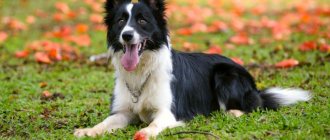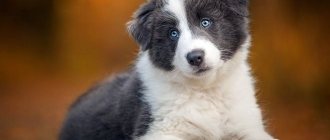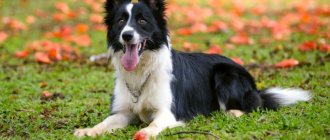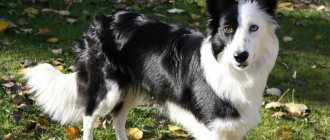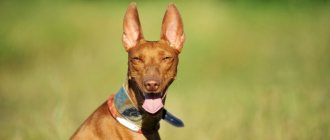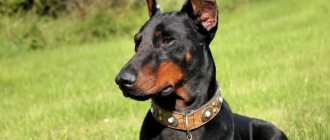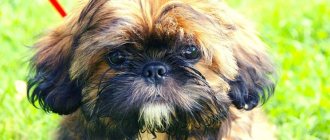History of Scottish Sheepdogs
The collie gets its name from the Dutch word for "helpful." The dog was used in Scotland as a sheep herder. Light and intelligent animals quickly coped with a herd of cattle and were useful on the farm. The herding instinct is no worse developed in modern collies, and they are used to breed new breeds. The group includes more than twenty different breeds that were derived from the Shetland Sheepdog and native dogs. Among the varieties known throughout the world are: Sheltie, Cumberland Sheepdog, Smithfield, English Sheepdog, Bearded Collie, Border Collie, etc.
How to choose a puppy
It is advisable to purchase a collie puppy from a nursery, where a purchase and sale agreement will be drawn up, a puppy certificate and other necessary documents will be issued, and you will be informed about the vaccinations given.
It should be taken into account that males are more independent and personable, females are easily trained, affectionate, and flexible. You can take your baby home at the age of 2-2.5 months. During this period, the puppies have already received the basics of socialization, and their character is at the stage of formation.
You should pay attention to your mother. She should be strong, not emaciated, healthy, well-groomed and active. Of the entire litter, focus your attention on the strongest, most energetic and friendly puppy. A small collie should have clean shiny fur and mucus-free eyes, strong limbs, and a straight back.
The cost of a collie depends on the exterior class, as well as the level of the nursery. If animals are taken from other countries for mating, the price will be much higher.
The most expensive show-class puppies are 90,000-120,000 rubles. If pedigree is not important, you can buy a collie for 6,000-12,000 rubles.
Description of the shepherd dog
The light breed, with thin paws and an elongated muzzle, is hardy and tolerates long journeys well. The dog is attached to its owner and perceives his entire family as a pack that needs to be taken care of. The dog will not let the children wander off during a walk, but will closely monitor everyone. The breed is suitable as a guide dog for people with disabilities, as it has a stable psyche and can easily learn any commands. The active and light animal tolerates temperature changes well and is suitable for keeping in an open enclosure. According to the research of the famous dog handler and writer Stanley Coren, the breeds included in the collie group are among the twenty most intelligent dogs. The Border Collie takes first place among all in intelligence and devotion.
Basic moments
Sensitivity and devotion allow dogs to be used as nannies, guards and companions. The Scottish Shepherd is ideal for family life.
She senses a person’s mood, responds to care and is ready to make any sacrifice for the sake of her owners.
A collie dog does not guarantee silence in the house, since it barks frequently and willingly. In this way, she conveys emotions and feelings to a person.
To maintain good health, your pet needs to lead an active lifestyle.
The best advertisement for the breed is the film “Lassie Comes Home,” which was filmed in 1943. Subsequently, many similar stories were filmed at American film studios. The film adaptations found a response among the audience and the popularity of the shepherd grew sharply.
Breed standard (appearance)
The dog of this breed is found in two types: short-haired and long-haired. Each has its own exterior features.
- Head. Triangular in shape with an elongated muzzle, the transition from the forehead to the nose is smoothed.
- Eyes. Almond-shaped from light brown to black.
- Ears. High-ranking, regular triangular shape. The tips of the ears should hang forward ⅓. But puppies' ears are delicate, and if you constantly stroke the dog's head, the ears will stand up and it will be difficult to put them in the correct shape.
- Tail. Straight saber-shaped, the tip is raised upward. According to the standard, the tail should not curl into a ring.
- Wool. Dense coat with fluffy and soft undercoat. The long-haired breed has long, soft-to-the-touch fur and a fox-like tail. The paws have a characteristic fringe. The smooth coat has a thick, hard coat and a dense undercoat. The coat fits tightly to the body and reliably protects the dog from humidity, cold wind, and heat.
- Colors. There are three color types of long-haired collies: sable, tri-color and blue merle. Sable color can range from fiery red to light sand. Tricolors have black and red markings on the head and paws, less often on the body. The blue merle or merle color is distinguished by its noble silver color with dark spots, black or gray. According to their exterior, merle dogs should have red spots on their paws and head, but their absence is not considered a deviation from the norm. All three colors of the longhaired breed have a chic white collar, which can be whole or broken in one place, a tassel at the end of the tail and white socks on the paws. On the hind legs only the very tips are colored white, the front legs are highly colored, almost to the elbow.
- Paws. Thin, tall, almost straight. The gait is calm with sweeping movements.
- Back. Straight, no sagging.
- Height at withers. For males from 56 to 61 cm, for females from 51 to 56 cm.
- Weight of an adult dog. From 19 to 34 kg, depending on the gender and appearance of the dog.
- Bite. Standard scissor. But due to the anatomical features of the muzzle, it bites the enemy with its front teeth. This helped the dog pull cattle out of a hole or hole without biting them.
Health, typical diseases
Collies live on average 13-16 years. Some types of long-haired dogs are susceptible to a number of diseases due to mutations in the MDR1 gene. In addition, they do not tolerate infectious diseases well. Individuals with a defective gene are sensitive to certain medications - antibiotics, steroids, opioids. To exclude collies with the mutant gene from breeding, genetic tests are carried out.
One of the most common hereditary congenital pathologies among Scottish dogs is cyclic neutropenia. “Grey collie syndrome” manifests itself in damage to stem cells and occurs when both parents are carriers of the mutant gene. The silver-gray coat color of affected puppies is often mistaken for blue merle. Dogs with this disease live for no more than six months.
The most vulnerable organ of a collie is the eyes. So, they are often diagnosed with:
- eversion and inversion of the eyelid;
- extra eyelashes;
- retinal atrophy;
- collie eye anomaly (CEA).
Sometimes puppies are born deaf. At risk are blue-eyed babies with blue merle coloring.
Not least on the list of congenital diseases is ectopia of the ureter, which, due to its incorrect location, results in disruption of the formation of the genitourinary system (urine incontinence in the bladder). The problem can only be eliminated through surgery.
In adults, degenerative myelopathy is often diagnosed, a pathology characterized by damage to the spinal cord. The disease occurs in a sluggish form, but if it is not treated and becomes chronic, the dog may partially or completely lose control of the hind limbs.
Collie skin diseases include:
- yeast dermatitis, which manifests itself as a result of a chronic illness that attacks the dog’s immune system;
- Pemphigus is a disease of idiopathic etymology that is autoimmune in nature (manifests in old age);
- vitiligo - destruction of pigments, due to which the color, skin, mucous membranes and corneas lose their natural shade (acquired, the causes are not clear, cannot be treated);
- photodermatosis due to prolonged exposure to the sun.
The collie's nervous system is also vulnerable. Thus, Scottish dogs are often diagnosed with epilepsy - a disorder accompanied by seizures and tremors. The disease cannot be treated; the well-being of the pet must be monitored by a veterinarian with preventive procedures carried out.
Collie character
Scottish Shorthair Sheepdog
The breed includes several varieties of dogs that share common characteristics:
- the shepherd is attached to its owner, but the cables try to dominate closer to one and a half years, so toughness of character is required in education;
- The shepherd instinct is in the animal’s blood, so the dog does not tolerate it when its family disperses in different directions. He will run vigorously and gather the whole family while picking mushrooms, walking in the forest or park;
- treat other animals in the house well. He will not chase strange cats on the street, only in the most extreme cases, when he gets bored;
- long-haired dogs are less active and do not like long games; short-haired dogs, on the contrary, prefer to run and jump endlessly;
- the breed is not suitable for keeping on a chain, since the breed needs to run at least 3 km per day;
- loves water and has a desire to swim in open waters in summer;
- the dog accepts children well and will play various games with them, steadfastly endures being grabbed by its fluffy tail or hugging its long muzzle;
- The dog is smart and remembers commands well; the breed often takes part in circus performances and is suitable as a guide dog. A good choice for beginner hobbyists;
- have a keen sense of smell and are used to find people under rubble;
- the dog has good endurance and is suitable as a companion for older people;
- Be wary of strangers and will monitor the owner’s attitude towards another person. If the owner shows complacency, the dog calms down and even allows himself to be petted;
- A vindictive breed, it remembers its offenders and can bite on the sly after some time.
A collie will be a great friend for your child and will brighten up the days of an elderly person, but the dog needs a daily walk without a leash. The medium size and light shape allow you to keep the dog in small apartments, but before buying a puppy you should take into account the animal’s thick undercoat. During shedding, dog hair will be everywhere, including the bed. Therefore, the breed is not suitable for lovers of ideal cleanliness in the house and people with a tendency to allergies.
https://youtu.be/LzLvC5Ye5rM
Pros and cons of collies
Collies, the description of the breed emphasizes this, were used as herding dogs. They made sure that the sheep and cows did not stray from the herd. They were used in places where there were no wolves or other predators.
At the genetic level, aggression is not inherent in them.
They easily get along in the family, and strive to find understanding not only with all household members, but also with other pets.
Important advantages:
- Attractive appearance
- Balanced character
- Complaisance and willingness to obey
- Ability to adapt to people's moods
- Unpretentiousness, which eliminates difficulties in care
- Quick wits
- Cleanliness
- Strong Natural Health
For harmonious development, the dog needs to be given attention. It is important not only to walk her regularly, but also to provide physical activity.
The disadvantages of the Collie dog breed include the following:
- Heavy shedding. For allergy sufferers, dog hair can be a health hazard.
- Emotionality. The pet accompanies most of its actions by barking and squealing.
- Cowardice. This problem occurs with poor socialization and is manifested by the emergence of fear when hearing loud sounds.
Caring for a Scottish Sheepdog
A dog with thick and long hair requires special care:
- Once every two days, the animal’s fur is combed with a special metal brush. During shedding, the dog needs to be brushed several times a day. A smooth-haired dog is also combed with a special metal comb; a brush with natural bristles will not comb the soft undercoat.
- The fringe on the front legs, fluffy pants and the tail of a long-haired dog constantly collects burrs, string seeds, and small sticks during walks. After each walk, the paws and tail are cleaned.
- In the summer, ticks can get into the animal’s thick fur, so before going for a walk, the animal is treated with a special spray.
- Once a month, the dog’s nails are trimmed, as the dog is active during walks and can damage its toes.
- Once a year, the wool is washed with a special mild shampoo. Long-haired dogs are additionally rinsed with a special detangling balm.
- Eyes and ears are wiped once every three days. Any antiseptics are used for treatment.
Immediately after the puppy arrives in the house, a place for a bed is selected. The rug should not be too soft or hard. When lying on a hard surface, the dog develops calluses on the elbows, which can fester and hurt.
Separately select a place for bowls for food and water. The bowls are placed on a special stand so that the dog does not have to bend down and wipe the floor near the bowls with a white collar every time.
Features of care
Caring for a collie is not easy. First of all, you need to decide where the dog will be kept. If outside, then get ready for your pet’s luxurious fur coat to lose its respectable appearance. If in an apartment, then you will have to deal with shedding hair covering carpets, furniture, floors, and provide your pet with long walks and physical activity. In both the first and second cases, care will be painstaking.
The coat needs to be combed once every 2 days, and daily during the molting period. If you let the process take its course, the fur coat will become matted and tangles will form on it, which can only be gotten rid of by cutting it out. You should bathe when dirty and in the warm season, since long hair is very difficult to dry. To prevent your pet from getting too dirty, it is better to take him out for a walk in dirty weather in overalls.
The eyes should be examined and wiped with a damp disc daily, ears and teeth once a week. Particular attention is paid to diet. Feeding your pet food from “your own table” is fraught with the development of gastrointestinal tract diseases and deterioration in the condition of the coat. The best option is balanced premium and super premium food. This pleasure is not cheap, but the health of the dog, practically a member of the family, is not something worth saving on.
Diseases and their prevention
The collie was bred for herding and the dog has good immunity to various viral diseases. Up to 6 months, the puppy is vaccinated against hepatitis, distemper and enteritis. Additionally, a rabies vaccination is given annually.
Before vaccination, the puppy is treated for internal and external parasites. Drops on the withers against fleas and ticks are suitable for treatment: Hartz Ultra Guard at a price of 450 rubles, Stronghold from 100 rubles, Bayer Advocate from 120 rubles. The following drugs are effective against worms for puppies: Milbemax from Novartis tablets from 600 rubles, Polyvercan from Ceva in the form of a sugar cube from 500 rubles, Procox from Bayer in the form of a suspension at a price from 450 rubles.
The long-haired breed is susceptible to various skin diseases:
- allergic reaction to food, most often manifested by chicken, some types of cereals and vegetables;
- staphylococcal skin infection. The animal's ears are the first to suffer. As a preventative measure, constant care of the dog is necessary;
- dermatitis due to too high temperature in the apartment. Treat using ointments: Ranosan, Baksinova, Diclorex
It is necessary to vaccinate your dog once a year. The date of vaccination and the drugs used are recorded in the veterinary passport.
Collie training
Collies are easy to train, and even an inexperienced amateur can teach a puppy basic commands: Sit, Come to me, Fu. But immediately after the puppy appears in the house, a nickname is chosen for him. It is better to name a dog with a sonorous and common nickname. The puppy learns its name during play and feeding. When the dog begins to respond to its name, it is necessary to praise it. Collies are an emotional breed and any command executed should be encouraged by your violent reaction.
After the puppy learns basic commands and remembers his name well, he is enrolled in OKD. During the main course, an experienced dog handler will show you how to properly teach a dog to walk next to its owner and perform other basic commands.
It is not recommended to punish a dog if it is stubborn in following a command. It is better to switch the dog’s attention to the game for a while, then return to training.
Attention! A strict metal collar is not suitable for training the breed. It will damage the dog's chic white collar.
It will be useful:
- basic training commands;
- nicknames for boys;
- nicknames for girls.
History of the breed
The history of the Scottish Sheepdog begins in the distant past in the highlands of Scotland. In ancient times, owners of herding sheepdogs called them “coels” and “collis”. After some time, the name “collie” appeared. According to some assumptions, it is believed that translated from Saxon it sounds like “dark”. The fact is that the Scottish sheep, which were guarded by collies, had a black muzzle, hence the name.
There is a second translation option with the subsequent appearance of the name. "Collie" literally means "helpful". This is what the owners decided to call the pet, who helped in everything, and whose main purpose was to work as a shepherd.
About two thousand years ago, Roman occupiers brought dogs with them to the islands of Britain, which became the founders of the Scottish Sheepdog. At first, representatives of the breed were similar in size to today's border collies; the main color of the animals was black. Over time, as a result of breeding work, collies became ideal shepherds, grazing and protecting herds of goats, sheep and other livestock. Their appearance has also changed for the better.
How the popularity of the Scottish shepherd breed grew not only in its homeland, but also in other countries, can be traced by dates:
- 1860 - Queen Victoria, during her stay in Scotland, was extremely pleased with the beautiful, intelligent dogs with a luxurious mane on their necks; these were Scottish Sheepdogs. The ruler brought several collies home with her and ordered them to be bred. This is where work began on improving this breed in England. In the same year, collies participated for the first time in a dog show in Birmingham.
- 1879 - The Scottish Sheepdog became a pet in America.
- 1886 - The first American Collie Club was created.
Feeding the Scottish breed
The puppy has a good appetite, but is prone to overeating. It is important to control the dosage of food. It is easier to feed the animal with ready-made dry food, which contains a sufficient amount of vitamins and minerals. According to owner reviews, the following food brands are suitable for Collie: Vet Life Dog Hypoallergenic Egg & Rice, Vet Life Dog UltraHypo, Pro plan medium adult sensitive skin.
A dog's diet on regular food should include the following foods:
- sea fish;
- lean meat: beef, veal, rabbit, turkey;
- offal and cartilage;
- cereals: buckwheat, rice, rolled oats;
- eggs;
- fermented milk products: cottage cheese, kefir, fermented baked milk, sour cream.
You should not give your dog potatoes, onions, chicken, or fatty meats.
The serving size depends on the age of the dog:
- from 1 to 3 months - serving no more than 200 ml. Up to 5 feedings per day with a 3-hour break. Complementary feeding should begin with formula milk and liquid porridge. By three months they switch to porridge cooked in low-fat meat broth. Every day one feeding is replaced with cottage cheese, kefir;
- from 3 to 6 months - 3-4 feedings per day, 350-450 ml. Meat products and eggs are added to the diet;
- from 6 months to 1 year - the puppy is gradually transferred to two meals a day. Offal and cartilage are added to the diet.
For dogs on natural and mixed food, vitamins and minerals are added to the diet: Zoovit Balance, Polydex Super Vul, Brewer's yeast from Excel.
The photo shows the sable color of the collie, with a predominant orange color. This color was used in the filming of the movie Lassie.
Marbled dogs look truly aristocratic. Dogs are sleeker and smaller in size.
A smooth-haired dog is much more active than its long-haired relative. The dog looks stocky and larger.
Breeders reviews
Alena: Collies are one of the smartest breeds. The dog can easily learn the most difficult tricks. The breed requires special care for its coat and only high-quality food, otherwise the dog will develop skin problems.
Igor: The breed is a herding breed, but after the ZKS it perfectly protects the owner and his property from strangers. It bites no worse than a German shepherd, and thanks to its light exterior, it quickly moves across a fairly large area.
Natalya: The collies of the old exterior were larger, the modern breed has become smaller. But outwardly it is difficult to confuse the breed with another, with luxurious fur, a collar and a fluffy tail. And the narrow and long muzzle makes the dog look like a cunning fox.
Attitude towards children and pets
Collies get along well with seven family members, including children. She will constantly watch over them and protect them from danger.
Always supervise any interactions between dogs and small children. Teach your child never to approach any dog while it is sleeping or eating, or to try to take food from it. No dog should be left unattended with a child.
Collies are also protective and affectionate towards other pets in their family.
Nurseries
You can buy a puppy with a pedigree in one of the nurseries.
In Russia:
- "Lavita" - https://kennellavita.com
- "ShaggyPack" - https://collierough.ru
- "Niksend" Moscow - https://niksend.com
In Ukraine:
- “Top Less” - https://collie.com.ua
Collie is one of the kindest and most sociable shepherd dogs that will become a loyal friend and brighten up your life. A dog with an attractive appearance, luxurious coat and easy-going character is suitable for any beginner.
Where to buy a collie puppy?
A specialized nursery is the best place to buy a good collie puppy. If pedigree and thoroughbred are important, then it is better to hire an experienced dog breeder to help. If not, then you can trust your heart. On nursery websites, there are customer reviews that will help you navigate. A little secret or life hack: visit a dog show where the desired breed will be presented. Chat with the owners of the breed, ask about the nuances, find out where they purchased the puppies. True dog breeders live for their pets, so they will be happy to answer any question and give valuable advice. Typically, nurseries send their representatives to exhibitions, where there is a chance to meet in person and take a business card.
How to choose a strong and healthy collie puppy
The day has come to go to the nursery for a cute puppy. Babies should be kept in a clean enclosure, without a specific unpleasant odor, which is very important. First of all, the breeder will demonstrate the numerous awards that his pets have received. Listen carefully, but don’t be easily fooled by all the big titles and championship accolades. If possible, you need to look at the parents of the future pet. Top 10 signs that will help you choose a healthy collie puppy:
- shiny and moist nose;
- clean ears, pink;
- lively, clear look;
- clean eyes, without any discharge;
- healthy skin, without parasites, sores and acne;
- silky, shiny coat;
- lymph nodes of normal size;
- tail without creases;
- no bloating.
A good proof that the animal is healthy is a written document of purchase and sale. If the collie puppy develops abnormalities over time, according to the contract, the pet can be returned. Having “insurance” with the buyer will reduce the risk that the seller will slip in a problem animal.
Age for adoption
- Professional Russian dog breeders advise buying 8-10 week old puppies. At this age, the baby should already be vaccinated, toilet trained, and receive basic education.
- An important point: it is not recommended to take a puppy home immediately after separation from its mother. Until 9 weeks of age, the baby learns dog language and learns to communicate with its own kind. He needs to spend several weeks in a doggy daycare.
- A professional breeder knows that a collie puppy less than 6 weeks old should not be given away. A very small puppy can only be given to an experienced owner who knows how to raise it correctly. This option is not suitable for a beginner.
- Depending on the breed, the puppy can be picked up earlier or later than 10 weeks of age. Large dogs grow more slowly, so it is recommended to remove them from kennels at the age of 3 months. Puppies of such breeds should gradually build up bone and muscle tissue, without sudden jumps, in order to avoid problems with the musculoskeletal system.
- For show- or breed-class collie puppies, the age of “adoption” can only be 6-9 months. This is a mandatory condition, because it is at this age that the makings of a champion and the distinctive signs of thoroughbred are revealed. You need to have patience to get a future titled champion.
Note : even the most expensive collie puppy cannot be 100% guaranteed to become a champion. The breeder’s job is to assess the potential and make a forecast. Next, you need to raise the puppy and train it for a long time in order to realize the makings of a champion.
Documentation
- A collie puppy has a mark in the groin area or it may be on the ear, as well as a puppy card (metric). The codes on the card and on the stamp must be identical.
- Metrica is the primary document that is issued for a puppy when it reaches the age of 45 days. Next, a qualified dog handler examines the babies and notes any defects found. The owner of the dog, if desired, can change the metric to a new document, pedigree, at the age of 6-15 months. This document will allow the pet to participate in breeding.
- Another document for the puppy is a veterinary passport, with mandatory vaccination and deworming notes.


